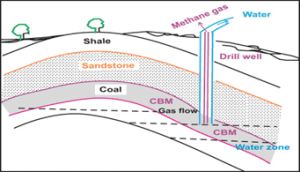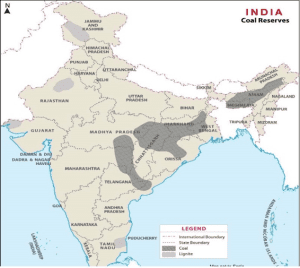Ans.
APPROACH
Introduction- Describe the formation of coalbed methane. Brief its uses and highlight India’s status globally regarding total coal reserves.
The Body
- Draw a related diagram showing its extraction or a map of India’s coalbed methane reserves.
- First, discuss in detail the potential reserves and distribution in India.
- Then elaborate on the challenges and issues concerning the extraction of CBM in India.
Conclusion- Present a way forward briefly for harnessing the CBM due to the advantages it offers.
Introduction: Coalbed Methane is considered as an unconventional source of natural gas which contains about 90-95% methane that gets adsorbed and stored in coal seams. It is trapped within the sedimentary coal seams during the process of coalification. During coalification, coalbed methane is formed either by microbiological or thermal processes when the temperature and pressure increase tremendously at greater depths while the organic matter undergoes transformation into coal. India has been endowed with the 5th largest coal reserves in the world, which demonstrates huge potential for coalbed methane in India.
The body
Traditionally, methane gas is released during coal mining, but the deliberate, scientific exploration of coalbed methane from coal seams has become popular in countries like USA and India due to the relatively lower carbon footprint of natural gas compared to coal and petroleum. Coalbed methane holds immense significance, given its diverse uses such as power generation, vehicular fuel in the form of compressed natural gas (CNG), methanol production, feedstock for fertilizers, etc.

Coalbed methane reserves in India:
India has vast reserves of bituminous coal of Palaeozoic and Tertiary ages that are prospective treasures of CBM, found at depths nearly 250-1200 m.

The prognosticated CBM resources in the country are about 92 TCF (2600 BCM) in 12 states of India, namely Chattisgarh, Jharkhand, Odisha, Andhra Pradesh, Tamil Nadu, Telangana, Madhya Pradesh, Maharashtra, Gujarat, Rajasthan, West Bengal and Assam.
The Gondwana belt of Eastern India houses the highest Coalbed Methane reserves in India.
The prospective areas for CBM exploration include Damodar Koel valley, Son valley, Raniganj coal block, Parbatpur block in Jharia, and West Bokaro coalfields. The Son Valley comprises two main blocks, namely Sonhat North and Sohagpur East and West blocks.
ISSUES IN EXPLORATION AND EXTRACTION OF ‘CBM’ IN INDIA:
Despite having CBM Prognosticated reserves of 92 TCF, the in-place reserves established are a meagre figure of 10 TCF which underscores the slow progress made with regard to the CBM exploration and extraction in India. The following challenges in this context stand as hindrances-
1. Geological issues in extraction- The process of de-watering initiates the extraction of CBM from coal matrix by drilling wells and pumping out the groundwater. With this, the pressure tends to reduce, making way for the CBM to be extracted. However, various physical-chemical-biological-thermal incompatibilities among clay particles, fluids, and coals tend to damage the coal formations. During the CBM-production phase, there can be matrix shrinkage or swelling caused by gas desorption/adsorption, leading to the change of cleat aperture.
2. Safety concerns- Often, fire accidents occur during the CBM extraction due to explosive atmosphere in gas wells. Coal being mechanically weak, can be easily fractured during injection testing. Risks concerning storage of methane are often ignored in the Environment Impact Assessment.
3. Technological constraints- CBM reservoirs throughout the world have different characteristics; hence developing and using optimum drilling and extraction technology as per local conditions is imperative. India lags behind in R&D and the application of suitable advanced technology to harness the CBM. It can be attributed to low budgetary allocation for CBM and insignificant participation of private players, given the higher risks involved and low returns on investment.
4. Environmental concerns-
a) Global warming: Methane is a potent greenhouse gas with global warming potential 25 times higher than that of carbon dioxide.
-
- UNEP estimates that methane has led to over 25% of the global warming that the world is experiencing currently.
- Methane emissions from Indian coal mines are projected to be 45 million tonnes of CO2 equivalent emissions over 20 years.
b) Water pollution: Concerns remain regarding the discharge of CBM reservoir water which has high saline content and heavy metals that have a direct bearing on the health of marine organisms and humans.
-
- The high sodium absorption ratio (up to 26) in coalbed methane water leads to problems of increased salinity in agricultural soils, losses to agricultural productivity, along with the depressed income of farmers in the affected regions.
c) Biodiversity loss: The mining of Coalbed Methane from coal seams leads to widespread deforestation and habitat fragmentation/destruction for the species inhabiting the region. Given the inflammable nature of methane and the passage of methane gas pipelines from under forests, the extent of biodiversity loss further aggravates the problem.
5. Forced Migration- The extraction of coalbed methane demands large land acquisition, which results in the displacement of the local population and problems in their rehabilitation. The CBM projects often face protests by locals due to fears of livelihood loss, environmental degradation and health concerns. For instance- the case of Chattisgarh in 2007, the Thanjavur protests (2010-2016) and the recent Neduvasal protests in Tamil Nadu
6. Policy failure- Although coalbed methane as a viable energy source was recognised as early as the 1990s in India when the CBM policy (1997) was introduced, the progress on identification, appraisal and commercial extraction of the resource has been lax. Out of 33 CBM blocks awarded through bidding between 2001 and 2008, only 5 blocks have made progress. The remaining blocks are still under development or in exploratory phase.
7. Institutional issues- Simultaneous operations of CBM and coal mining by different owners often cause management overlaps and issues over ownership. Also, there arise contentions between the Ministry of Coal and the Ministry of Power, both of which are involved in hydrocarbon exploration and energy production.
Conclusion:
The effective and optimum extraction and utilisation of CBM is crucial for India in view of India’s energy security, cutting import bills, reducing emissions and achieving the target of 15% gas in the energy basket of the country by 2030. A comprehensive approach through coordination of the Ministries of Coal, Power, Transport and Environment along with industrial participation and technical assistance from advanced nations (USA, Australia, Canada) is required to harness the full potential of coalbed methane in India.
Spread the Word



